Buzzing Billions: A Spectacle of Periodical Cicadas in 2024
Simultaneous Emergence of Two Broods
In 2024, nature will put on a grand show in the eastern United States as two periodical cicada broods, Brood XIX and Brood XIII, emerge simultaneously. This extraordinary event, happening once in a lifetime, will bring billions of cicadas to the surface after years of subterranean slumber. Get ready to witness a natural spectacle that will captivate your senses and leave you in awe.
Periodical Cicadas: A Unique Life Cycle
Periodical cicadas, renowned for their prolonged life cycle, spend the majority of their lives as nymphs, dwelling beneath the soil for either 13 or 17 years, depending on the brood. These remarkable insects undergo an astonishing transformation when they emerge from their underground existence, shedding their nymphal exoskeletons and transitioning into their adult form. Prepare to witness a breathtaking display of nature’s artistry as these creatures take flight.
Brood XIX and Brood XIII: A Rare Convergence
Brood XIX, commonly known as the Northern Illinois Brood, consists of three distinct cicada species and emerges every 17 years. Brood XIII, also known as the Great Southern Brood, comprises four species of cicadas and follows a 13-year cycle. The simultaneous emergence of these two broods in 2024 marks an exceptional occurrence that was last witnessed in 1803. Brace yourself for a once-in-a-lifetime natural phenomenon.
Geographic Distribution and Timing
Brood XIII will make its appearance in late April, extending into the first or second week of May. This brood will be predominantly visible across 15 states, primarily in the southern region, stretching from Virginia down to Alabama and Mississippi. Get ready to experience the cacophony of cicadas in states like Tennessee, Georgia, and North Carolina.
Brood XIX will emerge later, around mid-May, continuing until the first week of June. This brood will be heavily concentrated in four states: Illinois, parts of Wisconsin, Indiana, and a portion of Michigan. Residents of Chicago, Milwaukee, and Indianapolis will have a front-row seat to this extraordinary event.
A Symphony of Cicadas
As the ground temperature reaches an optimal 64 degrees Fahrenheit, the cicadas emerge from the soil and seek nearby trees. Once settled, the adult males begin their captivating chorus, producing a loud, distinctive sound that can surpass the noise level of a jet engine. This chorus serves as a mating call, attracting females to the trees. Prepare your ears for the mesmerizing symphony of cicadas, a sound that will surely leave a lasting impression.
Mating, Egg-Laying, and the Life Cycle Resumes
After mating, the female cicadas lay their eggs in tree branches, completing their life cycle. These eggs eventually fall to the ground, initiating the next generation of cicadas. The cycle continues as the nymphs develop underground for another 13 or 17 years before reemerging as adults. Witness the intricate dance of life as the cicadas fulfill their purpose in nature’s grand design.
A Fleeting Spectacle
The adult lifespan of a cicada is remarkably short, lasting only four to six weeks. While the sheer number of cicadas emerging may be overwhelming in certain areas, it’s important to note that these insects pose no harm to humans or pets. They neither bite nor sting, and their presence is a testament to the wonders of nature. Embrace the fleeting spectacle and marvel at the resilience of life.
Ecological Significance and Conservation
Cicadas play a crucial role in the ecosystem as a valuable food source for birds and small mammals. Their emergence provides a temporary feast for these animals. However, it’s essential to refrain from using pesticides during this period, as these chemicals can harm beneficial creatures like birds, small mammals, butterflies, and bees. Let’s all do our part to protect these fascinating creatures and preserve the delicate balance of nature.
A Rare Opportunity for Observation and Appreciation
The emergence of periodical cicadas is a unique and captivating natural spectacle. It provides an opportunity to witness the intricate workings of nature’s cycles and the resilience of life. Embrace the phenomenon, observe these fascinating creatures, and appreciate the beauty of this fleeting event. Share your experiences and knowledge with others, fostering a greater understanding and appreciation for the natural world.
Call to Action
Don’t miss this extraordinary natural event! Mark your calendars for 2024 and plan a trip to witness the spectacle of periodical cicadas. Bring your friends and family to share in this unforgettable experience. Together, let’s marvel at the wonders of nature and appreciate the beauty of life’s cycles.
